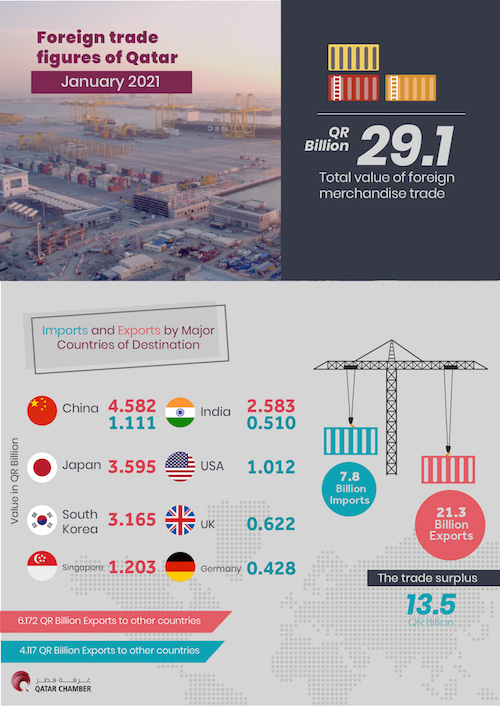The total value of Qatar’s foreign merchandise trade in January 2021 stood at QAR29.1 billion, reflecting a 13.7% growth compared to QAR25.6 billion in December 2020, according to the latest monthly economic newsletter of Qatar Chamber.
The March 2020 issue of the chamber’s newsletter cited figures from the Planning and Statistics Authority on the total value of Qatar’s foreign merchandise trade in January 2021, and the private sector’s exports according to certificates of origin issued by the chamber.
The newsletter, prepared by the QC Research and Studies Department, highlighted the report on the chamber’s activities last year which were presented by its Chairman, HE Sheikh Khalifa bin Jassim Al Thani, during their general assembly meeting on 3 March.
The newsletter also said that the total exports of goods in January, including those of domestic origin and re-exports, amounted to around QAR21.3 billion, showing an increase of 24.6% compared to QAR17.7 billion in December.
The imports of goods during the same month stood at QAR7.8 billion, showing a decrease of 8.2% compared to QAR8.5 billion in December.
Therefore, the country’s foreign merchandise trade balance, which represents the difference between total exports and imports, showed a surplus of QAR13.5 billion almost, recording an increase of 57% compared to QAR8.6 billion in December.
Trade exchange volume
The newsletter reported that China was Qatar’s largest trade partner in January with a trade exchange volume close to QAR5.7 billion or a share of 19.6% of Qatar’s total foreign trade.
Similarly, the private sector’s exports in January showed a significant month-on-month increase of 12.5% from QAR1.333 billion in December 2020 to QAR1.499 billion in January 2021.
The increase in the private sector exports is attributed to a considerable increase of 20.1% in exports through the general model certificate which increased by QAR160 million.
Exports through the Unified GCC to Singapore model also recorded a sharp increase of 966% (from QAR12 million to QAR129 million), followed by exports through the Unified Arab model which increased by 15%, and exports through the GSP Model certificate which increased by 7.1%.
While exports through the GCC model certificate decreased by 32.9%.
The newsletter also noted that the surge in the private sector’s exports emphasised the ability of the private sector and the national economy, in general, to overcome the repercussions of the COVID-19 pandemic and rebound to its levels before the pandemic.
In January, the private sector’s exports recorded the highest value during the past nine months with an increase of 162% compared to April 2020, which was the lowest value due to the precautionary measures to curb the pandemic, while it decreased by 23% compared to February 2020, which was the highest value.
Steel exports increased by 5000% from QAR3 million in December to QAR132 million in January, followed by chemical substances which increased by 62.2% and chemical substances which increased by 23.9%, latrine which increased by 4.8% and aluminium which increased by 11.2%.
On the other hand, exports of other commodities such as petrochemical, paraffin, essential oils and industrial gases showed a decrease of 28.1%, 8.6%, 3.5%, and 1.9%, respectively.
 India was at the top of the countries of destination for private sector exports with close to QAR309 million, or a 20.6% share of the total exports. It was followed by Oman with almost QAR207 million, or a share of 13.8%, and the Netherlands with about QAR135 million, or a 9% share.
India was at the top of the countries of destination for private sector exports with close to QAR309 million, or a 20.6% share of the total exports. It was followed by Oman with almost QAR207 million, or a share of 13.8%, and the Netherlands with about QAR135 million, or a 9% share.
Singapore came in fourth place with almost QAR129 million, a share of 8.6% and Hong Kong with about QAR112 million, a share of 7.5%.
The private sector exports to these countries represented 59.5% of the total value of exports during the same month.
As for economic blocs and groupings, Asian countries were at the top of economic blocs that received exports of private sector amounted to QAR891 million with a share of 59.4% of the total value, followed by GCC states with a share of 28.8% with exports of QAR258 million.
In third place came the group of EU states, with exports totalling QAR217 million representing 14.5% of the total value, followed by Arab countries excluding GCC states that received QAR68 million, a share of 4.5% and the USA with exports amounting to QAR46 million, a share of 3.1%.
The group of other European countries came in sixth place with exports amounting to QAR8.9 million, a share of 0.60%, followed by African countries (excluding Arab states) with exports amounted to QAR8.5 million, a share of 0.57% and other American countries which received exports of QAR1 million or a share of 0.07%.
Check out Marhaba’s FREE e-Guides for everything you need to know about Qatar.









